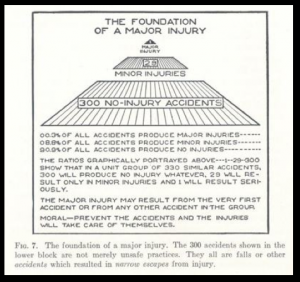Where Does the Accident Pyramid Come From?

Earlier this year, someone wrote me with the question, “Where does the accident pyramid come from?” I thought that others might be interested, so I am posting the answer here.
H.W. Heinrich was the source. In his book, Industrial Accident Prevention, 3rd edition, 1950, he published the following figure:
As I understand it, this came from his experience in the insurance industry in the 1920 and early 1930s. (Not exactly a recent source of research.)
Note that the original pyramid from the 30s has changed to the one we see today with “unsafe acts” at its base.
Here is an article that takes issue with Heinrich’s accident pyramid:
https://concreteproducts.com/mag/concrete_reevaluating_incident_pyramid/
One online source (now deactivated) actually had the following statement:
Heinrich reclassified 15% of the records originally classified as unsafe conditions to unsafe acts. By adding that 15% to the 73% that were initially recorded as unsafe acts, he concluded that 88% of all industrial accidents were caused primarily by unsafe acts of persons. During the same period of time the National Safety Council published a study that indicated that 87% of the industrial accidents were caused by unsafe acts and 78% by mechanical hazards. (The National Safety Council study allowed cases to be classified with multiple causes.) One can conclude from the National Safety Council that many industrial accidents of this era involved recognized mechanical hazards.
I like the concept that the pyramid represents – small problems can cause big accidents. I’m not sure that the concept should totally drive a safety program.
What do you think?




